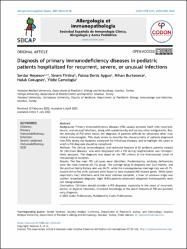| dc.contributor.author | Nepesov, Serdar | |
| dc.contributor.author | Firtina, Sinem | |
| dc.contributor.author | Aygün, Fatma Deniz | |
| dc.contributor.author | Burtenece, Nihan | |
| dc.contributor.author | Cokuğraş, Haluk | |
| dc.contributor.author | Camcıoğlu, Yıldız | |
| dc.date.accessioned | 2022-07-19T06:02:52Z | |
| dc.date.available | 2022-07-19T06:02:52Z | |
| dc.date.issued | 2022 | en_US |
| dc.identifier.citation | Nepesov, S., Firtina, S., Aygün, F. D., Burtenece, N., Cokuğraş, H. ve Camcıoğlu, Y. (2022). Diagnosis of primary immunodeficiency diseases in pediatric patients hospitalized for recurrent, severe, or unusual infections. Allergologia et Immunopathologia, 50(4), 50-56. http://doi.org/10.15586/aei.v50i4.605 | en_US |
| dc.identifier.issn | 0301-0546 | |
| dc.identifier.issn | 1578-1267 | |
| dc.identifier.uri | http://doi.org/10.15586/aei.v50i4.605 | |
| dc.identifier.uri | https://hdl.handle.net/20.500.12511/9582 | |
| dc.description.abstract | Background: Primary immunodeficiency diseases (PID) usually presents itself with recurrent, severe, and unusual infections, along with autoimmunity and various other malignancies. But, the diversity of PID often makes the diagnosis of patients difficult for physicians other than clinical immunologists. This study aimed to describe the characteristics of patients diagnosed with PIDs during the inpatient treatment for infectious diseases, and to highlight the cases in which a PID diagnosis should be considered. Methods: The clinical, immunological, and molecular features of 81 pediatric patients treated for infectious diseases, who were diagnosed with a PID during hospitalization was retrospectively analyzed. The diagnosis was based on the PID criteria of the International Union of Immunological Societies. Results: The five main PID sub-types were identified. Predominantly, antibody deficiencies were the most common (61.7%) group. The average delay in diagnosis was 34.6 months, and the positive family history rate was 24.7%, while the consanguineous marriage rate was 45.7%. Around thirty-five (43%) patients were found to have mutated PID-related genes. While lower respiratory tract infections were the most common symptom, a fever of unknown origin was another remarkable diagnosis. Eight (9.9%) patients underwent allogeneic hematopoietic stem cell transplantation. Conclusions: Clinicians should consider a PID diagnosis, especially in the cases of recurrent, severe, or atypical infections. Increased knowledge of the alarm features of PID can promote early diagnosis. | en_US |
| dc.language.iso | eng | en_US |
| dc.publisher | Codon Publications | en_US |
| dc.rights | info:eu-repo/semantics/openAccess | en_US |
| dc.rights | Attribution 4.0 International | * |
| dc.rights.uri | https://creativecommons.org/licenses/by/4.0/ | * |
| dc.subject | Children | en_US |
| dc.subject | Primary Immunodeficiency | en_US |
| dc.subject | Infection | en_US |
| dc.subject | Severe Combined Immunodeficiency | en_US |
| dc.subject | SCID | en_US |
| dc.title | Diagnosis of primary immunodeficiency diseases in pediatric patients hospitalized for recurrent, severe, or unusual infections | en_US |
| dc.type | article | en_US |
| dc.relation.ispartof | Allergologia et Immunopathologia | en_US |
| dc.department | İstanbul Medipol Üniversitesi, Tıp Fakültesi, Dahili Tıp Bilimleri Bölümü, Çocuk Sağlığı ve Hastalıkları Ana Bilim Dalı | en_US |
| dc.authorid | 0000-0002-4551-5433 | en_US |
| dc.identifier.volume | 50 | en_US |
| dc.identifier.issue | 4 | en_US |
| dc.identifier.startpage | 50 | en_US |
| dc.identifier.endpage | 56 | en_US |
| dc.relation.publicationcategory | Makale - Uluslararası Hakemli Dergi - Kurum Öğretim Elemanı | en_US |
| dc.identifier.doi | 10.15586/aei.v50i4.605 | en_US |
| dc.institutionauthor | Nepesov, Serdar | |
| dc.identifier.wosquality | Q4 | en_US |
| dc.identifier.wos | 000828751900006 | en_US |
| dc.identifier.scopus | 2-s2.0-85133287004 | en_US |
| dc.identifier.pmid | 35789402 | en_US |
| dc.identifier.scopusquality | Q3 | en_US |



















